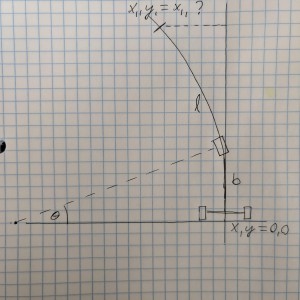How can I find steering angle if the only information I have is arc length, vehicle length, and how far my vehicle is off course?
Lets say I have a vehicle that has a bad alignment. I want to know the angle I need to turn the steering in order to drive a straight line. I can send the vehicle forward a known distance (l), I know the vehicle length (b), and I know how far it ends up off course at the end of it's path (x). I do not have the radius or angle of the arc. How can I find the steering offset (see attached photo)?
What I've tried:
I was able to find the steering angle in terms of x2,y2 by using an offset circle:
$$\left(x-\left(\frac{b}{\sin\theta}\right)\right)^2 + y^2 = \left(\frac{b}{\sin\theta}\right)^2$$
Then solving for $\theta$:
$$\theta = \operatorname{arcsin}\left(\frac{2bx}{x^2+y^2}\right)$$
BUT, I don't know $y$
 Bcherb2
Bcherb2
Answer
- The questioner was satisfied with and accepted the answer, or
- The answer was evaluated as being 100% correct by the judge.
1 Attachment
-
I do have a question. I am using Excel's solver to find r by iterating x. I entered values of L=50m, B=0.9m, and iterated until x converged on 0.3m. Doing this I get a radius of around 1m. If I plug the same numbers in the equation in my problem statement, I get a radius over 4000m. Any ideas?
-
The newton's algorithm will converge to r and not x. Make sure you are not confusing r with x. If you run the Newton's algorithm, it should converge to r and not x. Double check and let me know.
-
There are algorithms to find roots of a nonlinear function. You may also use the intermediate value theorem. See http://www.sosmath.com/calculus/limcon/limcon07/limcon07.html
-
Nice, that worked! I actually had found r-rcos(l/r)=x, but dismissed it because I did not understand how/why I needed to find the roots as you just described. Thank you so much.
- answered
- 1623 views
- $7.00
Related Questions
- Transform equation $r=6 cos (\theta)$ from Polar to Rectangular, and identify the graph
- Analyzing Concave Down Segments of the Sinusoidal Curve
- Determine formula to calculate the radii of a unique ellipsoid from coordinates of non-coplanar locii on its surface, and without knowing its center or rotation angles.
- Find the volume of a 3D region bounded by two surfaces
- Make a 2D polygon - but all the side lengths (bar one) are whole numbers, and all angles are multiples of 22.5
- Direction of forces acting on points A, B and C
- Pulley System
- Geometric Representation Problem

